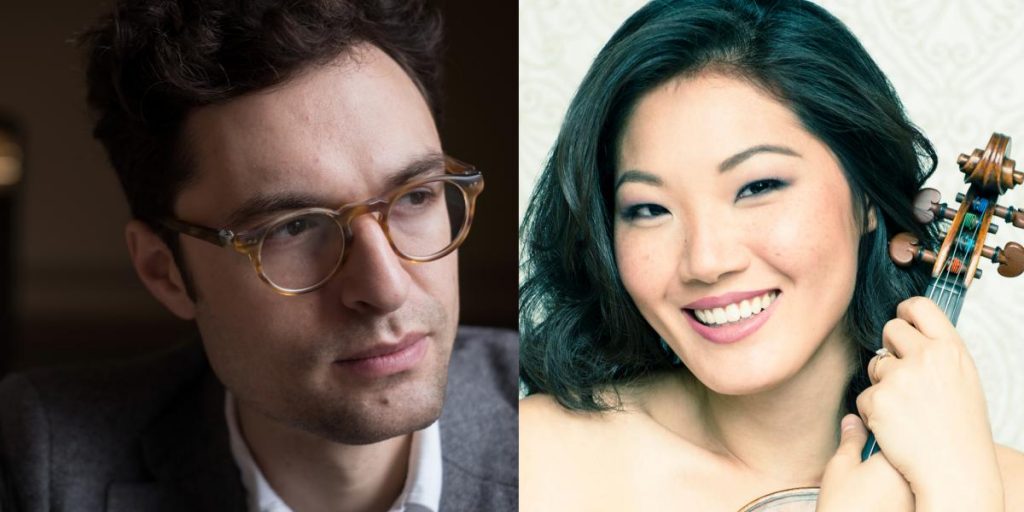Andres and Priday stream wide-ranging American recital for Phillips Collection

“Welcome to my living room.” With those words, Timo Andres introduced an 80-minute concert streamed by the Phillips Collection Sunday afternoon. Rather than coming to the museum’s music room, the American pianist and violinist Rachel Lee Priday recorded their program of American music in New York.
The musicians anchored their selections on three violin sonatas, including two classics of this repertoire. First came the most recent, composed by Christopher Cerrone in 2015 for Priday. Cerrone has said that trying to combine the timbres of these two instruments led him to write this piece as if for “a single meta-instrument, part violin and part piano.”
Priday opened the first movement with the fleeting sound of delicate harmonics in Doppler-effect waves. At his Bösendorfer, Andres imitated the sound with repeated notes in the treble register, adding tremolos in the middle register, and finally engulfing the violin as the full range kicked in. The process unfolded in the reverse in the slow second movement, with the violin picking up the heavily pedaled pings of the piano in pizzicato and long, bowed notes.
The third movement tried to represent the fusion of the two, although it seemed that none of the strengths of either instrument made it past the operation. It is just cruel to require a pianist to labor over that many repeated notes, something relatively effortless on a violin. The paucity of the musical materials, with an extremely limited harmonic scope and not much melodic sweep for the violin only magnified these issues.
Solo pieces then split the meta-instrument back into its parts. Andres played Robin Holcomb’s Wherein Lies the Good, a suite of miniatures setting faux-American folk songs. Evocations of ragtime, nursery songs, Ivesian bitonality, and shape-note tunes flitted by. Snatches of melody feinted in the direction of “Turkey in the Straw,” “Simple Gifts,” or “On Top of Old Smokey.” The final section, a tender hymn tune, ended on an uncompleted plagal cadence, the first part of the “Amen” after a hymn, but without the choir ever switching to the final syllable.
Priday was more assertive with Three Suns, a virtuosic solo etude that Andres composed for her in 2018. Double-stops and arpeggios patterns piled up in repetitive loops, which the violinist dispatched effortlessly.
Between the two older sonatas came Julia Wolfe’s Mink Stole, a frantic moto perpetuo piece premiered at the Kennedy Center in 1997. This work had a diverting harmonic range, featuring lots of hammered polychords on the piano, reminiscent of Stravinsky’s Petrushka, but no appreciable melody emerged other than arpeggiation of the chord patterns. Both players showed exceptional endurance in weathering its forceful style.
The oldest work on the program, Ives’ Violin Sonata No. 4, was the high point of the program. Subtitled “Children’s Day at Camp Meeting,” the work’s three movements are based on the composer’s memories of the church gatherings he attended in his youth. Ives’s father conducted his band and led singing at these events, and one day was given over to the kids, with predictable antics from the boys, pranks which loomed large in the composer’s reminiscences.
Andres attacked the polytonal excursions in the first movement with agile finesse, but in the dreamy second movement, as in other selections with less flash, a more subtle range of touch was needed. This left the spotlight in the slow movement to Priday, who coaxed an expressive legato line on the paraphrase of the hymn “Jesus Loves Me,” often disguised by adventurous harmonic shifts. The third movement turned raucous again, rendering “Shall We Gather by the River” as an enthusiastic march of insistent dotted rhythms.
Priday relished the chance to luxuriate in her instrument’s silken melodic power even more in the elegiac sections of Aaron Copland’s Violin Sonata. The energetic parts of the outer movements, enlivened with the feel of a hoedown, had as much drive and activity as the later works by Cerrone and Wolfe, as well as the harmonic and melodic variety that was missing from them. Priday, skillfully assisted by Andres, knew exactly what to do with what the score had given her.
This recording can be streamed, along with many other recordings from the museum’s virtual season. phillipscollection.org
